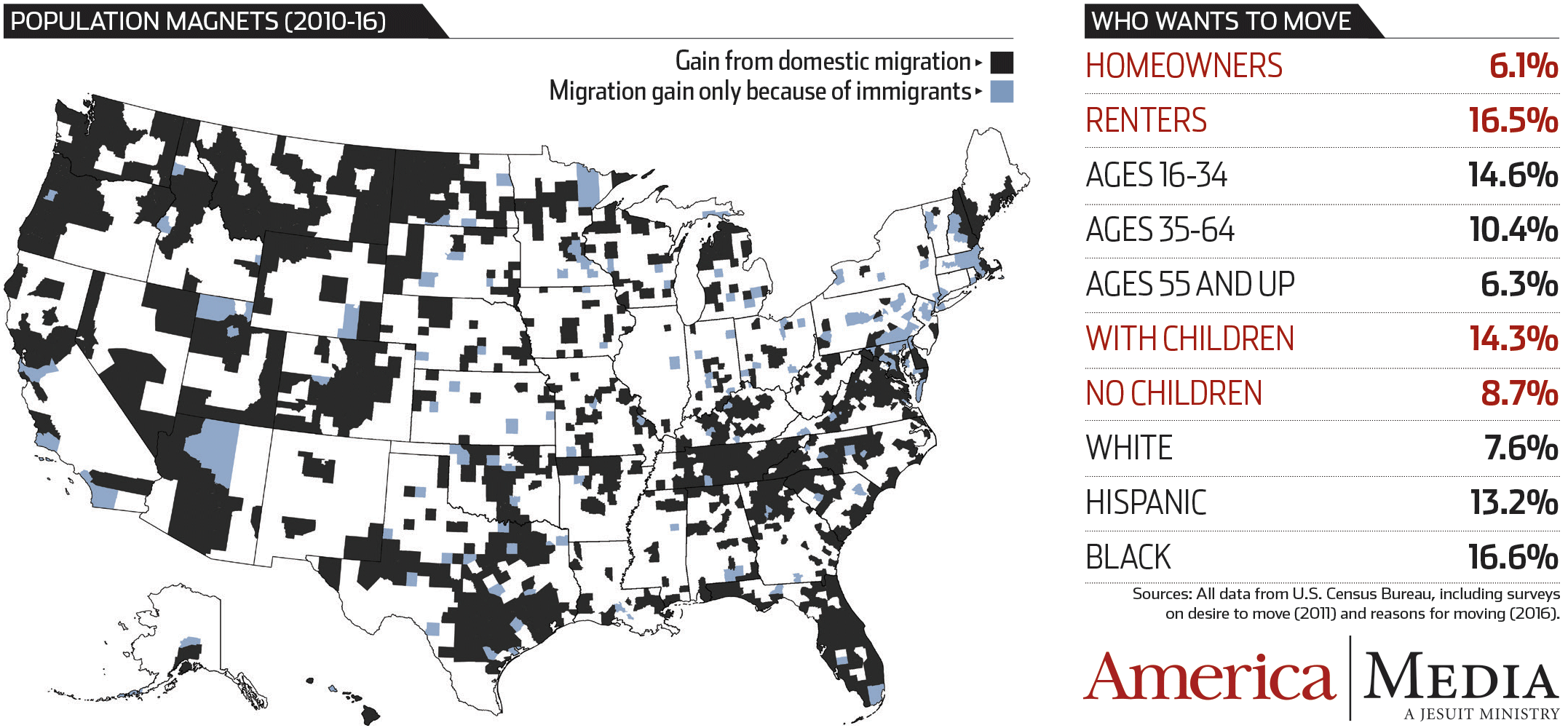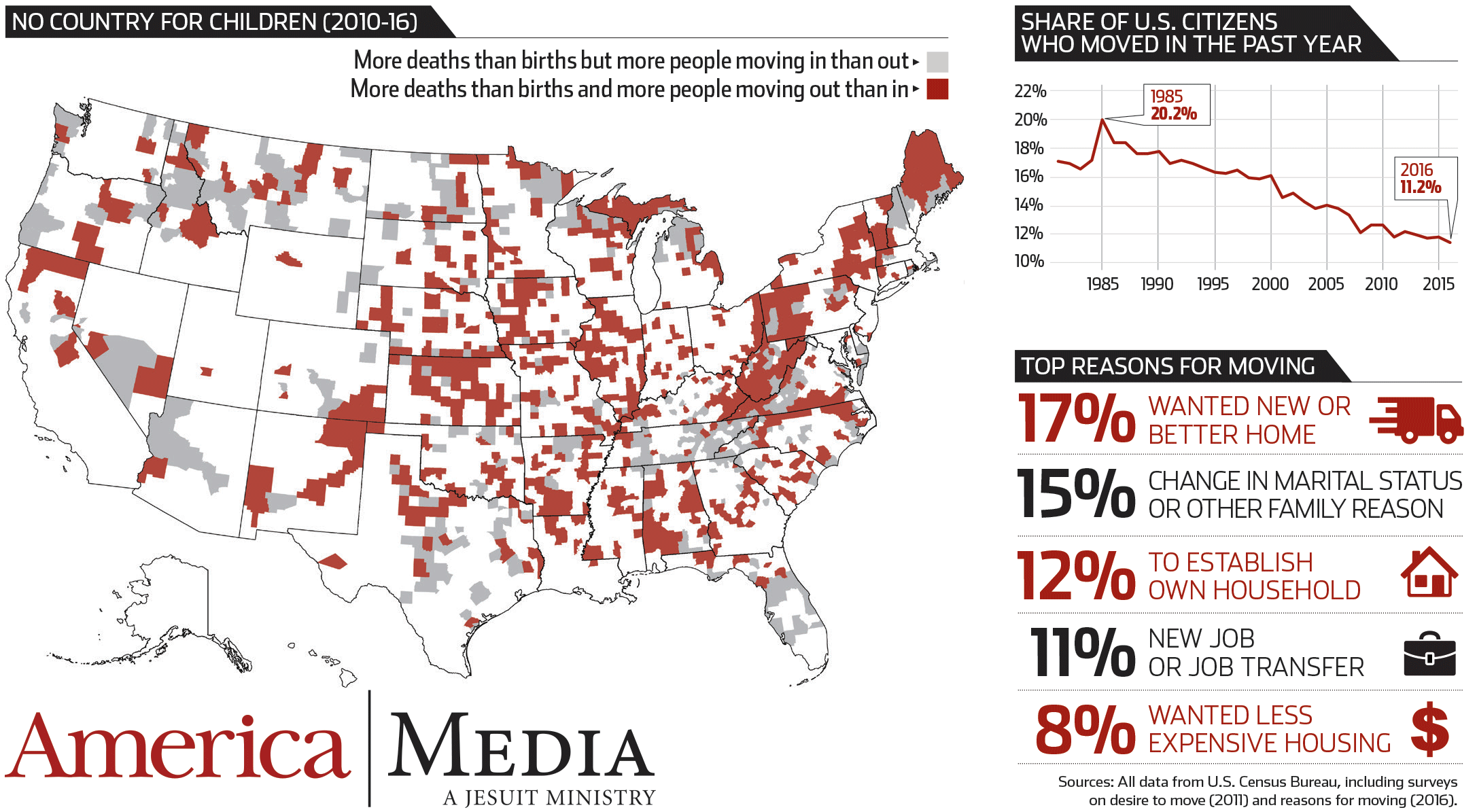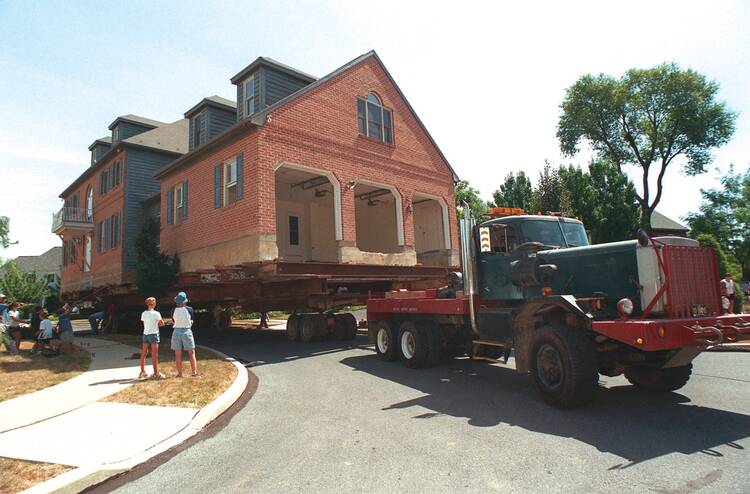Americans are staying put. The Census Bureau reports that only 11.2 percent of the United States population moved between 2015 and 2016. That is still a high number compared with most of Europe, but it was the lowest rate since the government began tracking migration in 1948. In that year, during a postwar baby boom and an expansion of housing into the suburbs, the annual moving rate was 20.2 percent.
The idea that we are in a period of residential stability may seem counterintuitive, given the economic turmoil of the past decade. But many economists are concerned about the low moving rate. For most of U.S. history, geographic mobility was a grease that helped economic growth and innovation. Unemployed or underpaid workers frequently moved to areas where there was a high demand for labor and higher wages (which also helped reduce the labor supply, and thus raise wages, in the places they left behind).

That seems to be happening far less now, in part because relatively high-wage areas also have very high housing costs. In our uneven economic recovery, a small set of highly skilled workers migrate to, and stay in, a handful of thriving metropolitan areas. Unable to afford a long-distance move, others remain in places with few job opportunities and declining populations. The economist Richard Florida writes that workers in the United States are increasingly divided into three categories: “the mobile, who derive the benefits of economic dynamism; the stuck, who are trapped in place and unable to move; and the rooted, who are strongly embedded in their communities and choose not to.”
The low moving rate belies some major changes in population distribution. From 2010 to 2016, almost two-thirds of the 3,142 counties (or their equivalents) in the United States suffered a net loss in domestic migration, with population magnets in states like Arizona, Florida, Nevada and Texas pulling people from the rest of the United States. In 166 counties, enough international immigrants arrived to offset the loss of U.S.-born residents and keep the population growing. These included Miami-Dade, counties in California and scattered across the Midwest and in counties and cities in the Northeast, including New York and Boston.
Large swaths of the Appalachian and Great Lakes regions, plus rural parts of almost every state, are steadily losing residents without attracting significant numbers of immigrants.
But large swaths of the Appalachian and Great Lakes regions, plus rural parts of almost every state, are steadily losing residents without attracting significant numbers of immigrants. In more than 800 counties, not only are more people moving out than in, more people are dying than being born. These counties are concentrated in Rust Belt states like Ohio and Pennsylvania that almost uniformly swung toward the Republican candidate, Donald Trump, in the 2016 election.
Places with steady population losses face severe economic challenges, as the number of both skilled workers and potential customers dwindles. Alvin Chang, writing for the website Vox, points out that the lower moving rate may be especially bad news for small towns, which are seeing fewer “returnees”—that is, people who leave town to get an education or travel during their young adulthood, then come back to raise families and perhaps start businesses. These days, he writes, “fewer people are coming back with the human capital these towns so desperately need.”

The returnees (and the “rooted,” who never leave their hometowns in the first place) implicitly raise a moral question: Do high-skilled workers have an obligation to the communities that nurtured and educated them? There is also a moral dimension to the idea that people should continually move to where there are more job opportunities: Is it wrong to force mobility on people who wish to stay rooted in communities they love? Are small towns to be another casualty of our throwaway culture?
In “Laudato Si’,” Pope Francis writes about protecting “our common home.” Most discussion of the encyclical has centered on the health of our planet, but there is also a clear theme of our obligations on a smaller scale. The pope celebrates “local individuals” with “a strong sense of community, a readiness to protect others, a spirit of creativity and a deep love for the land” (No. 179).
The Catholic principle of subsidiarity, that government “should not replace or destroy small communities and individual initiative,” is also strengthened when individuals give back to the communities where they were raised. But “dying counties” are now experiencing crises, including a rising suicide rate and opioid addiction, that they may not have the resources to deal with, necessitating more intervention from federal and state governments.
Mr. Chang cites researchers who found that “returnees” to hometowns almost always had family members still there and “felt the need to give back to their community with the skills and experiences they accrued elsewhere.” Perhaps the problem with the moving rate is not that it is low but that it is overwhelmingly in one direction.











A low rate of moving may be related to the aging of the population because people tend to move less as they get older. Moving has a high price, both financially and in the rending of social connections. Perhaps jobs should move to accommodate people instead of people moving to accommodate companies needing workers. Another possibility is that people stay in rural areas because of their health. Anyone sensitive to polluted air cannot live in the average city.
People, especially our growing retiree population, move from high cost areas like New York, Chicago and California, to lower cost areas like Florida, North Carolina, Arizona, Texas etc. Sometimes this is due to better job opportunities or to reduce their overall living expenses. Granted that some people cannot or will not move for a whole host of reasons.
However, there is a much bigger problem. Whether people move or not the bigger problem is the fact that many communities in the U.S. have a large percentage of the population who are living pay check to pay check and far too many are poor or near poor. That is the bigger problem we need to deal with.
This article illuminates one aspect of what might be a significant societal development in the U. S. That is, the constrained mobility of our population not only socially, but also occupationally, educationally, and economically as well as physically as described here. While any broad societal trend such as the one suggested by this physical mobility indicator must certainly be due to a multiplicity of causal factors, some of these can at least be suggested by observations about one professional group over three generations.
The experience of electrical, electronic, computer and communications engineers over the last sixty or so years is illustrative. In the 1950s and 1960s these professionals found rewarding livelihoods in electrical power and telecommunications utilities, radio, radar, automatic control systems and automatic business machines products and systems, and were trained and educated at established universities that mostly fed graduates into well established industries plus the federal government. Geographically the centers of employment for these professionals were remarkably diverse and evenly distributed. Aside from the obvious concentrations around Stanford, Berkely, MIT, Lincoln Labs and similar institutions that generated new businesses and accelerated older ones, NASA and the Department of Defense and their associated prime and sub contractors brought expansions and startups to every state on the Gulf coast. Some of these latter hotbeds of technological and scientific activity no one would have foreseen a decade or so earlier, such as Redstone Arsenal, Alabama, the Mississippi rocket propulsion test facility, the New Orleans rocket engine fab plant, etc. In addition, there were businesses doing work in advanced analog and digital communications in Iowa, Kansas, New Hampshire, Oregon, Pennsylvania and many other locations that, in the 21st century, are not readily associated with advanced technological industries. Moreover, engineers and technicians wanting to move to these locations were often surprised by how pleasant these places turned out to be to raise a family. Often, in fact, if a family found a need for two earners, a spouse could find interesting and rewarding work as well.
Technological and scientific change, together with changes in government spending priorities began to affect this pattern in the 1970s and 1980s and those influences strengthened and accelerated in the 1990s. It is true that the end of the Cold War and mounting federal budget concerns reoriented federal spending that had consequences for defense and aerospace electronics requirements. But also, advances in computers and computing changed everything.
Change struck not just in terms of the challenge to academic institutions to supply to industry scientists, engineers, and certainly fabrication technicians, who could literally invent, design and miniaturize, but also in terms of whole new occupations that arose such as software architects, engineers and programmers. And the profusion of professional sub-specialties that evolved in these new occupations was amazing and continues to the present time. But steadily throughout that period locational imbalances in the needed skills appeared that have only increased to the present day. Areas that once provided steady, challenging, well-paid employment in these professional areas experienced technological obsolescence and loss of jobs, and fewer and more highly concentrated areas experienced shortages of personnel with the right education and experience. Again, the locations experiencing acute shortages became magnets for explosive population growth and again, the fact that these areas were proximate to certain educational institutions, as well as networks of venture capitalists who had clustered nearby as early as the 1950s, was not an accident. It wasn’t long before these areas became overcrowded. Housing costs rose, schools became overcrowded, more families found the need to have both spouses work outside the home, municipal governance fell behind the need for public safety services, and the good old days of technical and scientific employment seemed a fading memory.
In the 21st century, there are educated and experienced persons who cannot afford to move to these areas of high concentration, not just for economic reasons, but for all of the reasons that economics impacts, such as forced 2-hour commute times because no family can afford to live close to the place of employment. One might think that in these conditions wages would rise to whatever level was required to achieve supply/demand equilibrium. It is not happening, and one of the main reasons is the H1b visa and its abuses. Highly educated and experienced personnel, mostly from India, who speak English, are clustered in large communities in these areas of purported skill shortages. Many in these “little Mumbai” communities have achieved their academic credentials from U. S. institutions, and they work for lower wages than a U. S. engineer with a family can live on. Why? One reason is that they are largely unaccompanied adult males, often sharing small apartments with others under appalling living conditions. They mostly work under contract for large, high tech corporations, for 12 to 18 months at a time and then move on to the next contract. A U. S. native with a family can experience this nomadic existence for a while, but it is not a sustainable way of life. A U. S. native will eventually leave the profession under these conditions. Moreover, aspiring U. S. student engineers and scientists are not stupid. They will have surveyed the wage levels and living and working conditions in their intended field and have decided “never mind.” Thus, the skill shortage that the high tech industry purports to experience is a self-fulfilling prophecy. And the low geographic mobility observable among American high tech workers is at least partially explained. As Yogi Berra is reported to have said, “Nobody goes there any more. It’s too crowded.”